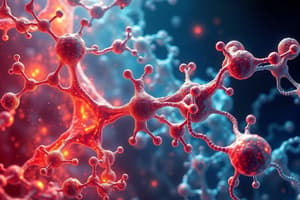Podcast
Questions and Answers
Which of the following is NOT an application of biophysics?
Which of the following is NOT an application of biophysics?
- Drug Discovery
- Political Science (correct)
- Diagnostics
- Material Design
Electromagnetism is unrelated to the behavior of ions and small molecules in cells.
Electromagnetism is unrelated to the behavior of ions and small molecules in cells.
False (B)
Which area of biophysics primarily focuses on the structure and function of biomolecules?
Which area of biophysics primarily focuses on the structure and function of biomolecules?
- Biomechanics
- Cellular Biophysics
- Molecular Biophysics (correct)
- Systems Biophysics
Biophysics exclusively focuses on cellular processes and does not involve physical principles.
Biophysics exclusively focuses on cellular processes and does not involve physical principles.
Name one important concept in biophysics that relates to energy transformations in biological systems.
Name one important concept in biophysics that relates to energy transformations in biological systems.
Biophysical principles are beneficial to advancements in __________ and drug development.
Biophysical principles are beneficial to advancements in __________ and drug development.
What technique is used to determine the three-dimensional structure of molecules?
What technique is used to determine the three-dimensional structure of molecules?
The area of biophysics that studies the forces and motion involved in biological systems is known as __________.
The area of biophysics that studies the forces and motion involved in biological systems is known as __________.
Match the following biophysical concepts with their descriptions:
Match the following biophysical concepts with their descriptions:
Match the following biophysics techniques with their primary function:
Match the following biophysics techniques with their primary function:
Flashcards
Biophysics
Biophysics
The study of biological systems using the principles of physics and chemistry.
Molecular Biophysics
Molecular Biophysics
Focuses on the structure and function of molecules important for life, like proteins and DNA.
Cellular Biophysics
Cellular Biophysics
Examines the physical processes happening inside cells, like how substances move across the membrane.
Biomechanics
Biomechanics
Signup and view all the flashcards
Biomaterials
Biomaterials
Signup and view all the flashcards
Thermodynamics in Biophysics
Thermodynamics in Biophysics
Signup and view all the flashcards
Statistical Mechanics in Biophysics
Statistical Mechanics in Biophysics
Signup and view all the flashcards
Drug Discovery in Biophysics
Drug Discovery in Biophysics
Signup and view all the flashcards
Diagnostics in Biophysics
Diagnostics in Biophysics
Signup and view all the flashcards
Fluid Dynamics in Biophysics
Fluid Dynamics in Biophysics
Signup and view all the flashcards
Study Notes
Introduction to Biophysics
- Biophysics is an interdisciplinary field applying physical and chemical principles to biological systems.
- It explores biological structures and processes from molecular to organismal levels.
- It combines techniques from physics, chemistry, mathematics, and biology.
- Biophysics aims to understand the physical basis of biological phenomena.
Areas of Study within Biophysics
- Molecular Biophysics: Focuses on the structure and function of biomolecules (proteins, DNA, RNA). Techniques include X-ray crystallography, NMR spectroscopy, and cryo-electron microscopy.
- Cellular Biophysics: Explores transport, signal transduction, and mechanical properties within cells. Key areas include membrane potentials, intracellular transport, and cell signaling.
- Systems Biophysics: Studies interactions and emergent properties of large biological systems. Uses computational modeling for complex biological networks (e.g., gene regulatory networks, protein-protein interactions).
- Biomechanics: Applies physical principles to living organism movement. Studies forces and motion in biological systems (muscles, bones, joints). Includes gait and posture analysis.
- Biomaterials: Examines physical characteristics of biological materials (cell walls, cartilage, skin). Aims to understand material properties and function.
Key Techniques in Biophysics
- X-ray Crystallography: Determines 3D molecular structure by analyzing X-ray diffraction from crystalline samples.
- Nuclear Magnetic Resonance (NMR) Spectroscopy: Provides structural and dynamic information about molecules through their magnetic field response.
- Electron Microscopy (including cryo-electron microscopy): Creates high-resolution images of biological structures, particularly useful for complex molecular assemblies and large molecule visualization.
- Fluorescence Microscopy: Visualizes specific molecules/structures within cells using fluorescent tags. Allows observation of dynamic processes in living cells.
- Computational Modeling: Uses mathematical models to simulate and analyze biological systems (e.g., protein folding, enzyme kinetics, cellular processes).
Applications of Biophysics
- Drug Discovery: Predicts drug-target binding affinity, exploring new treatment mechanisms.
- Diagnostics: Develops new diagnostic tools using physical principles.
- Materials Science: Designs biocompatible materials for medical implants.
- Agriculture: Increases crop yields/develops pest-resistant crops by understanding molecular-level biological processes.
- Environmental Science: Studies interactions between biological systems and their environment, including microbial activity.
Important Concepts in Biophysics
- Thermodynamics: Understands energy transformations in biological systems.
- Statistical Mechanics: Studies the behavior of large numbers of molecules.
- Electromagnetism: Explores electrical potentials/currents in cells and ion/small molecule behavior.
- Quantum Mechanics: Relevant at the molecular level, specifically in electron transfer pathways and atomic structure/reactions.
- Fluid Dynamics: Studies fluid transport/motion (blood flow, diffusion, intracellular transport).
- Mechanics: Understands forces and movements within living systems.
Relationship to other Fields
- Molecular Biology: Biophysics provides a framework for understanding cellular/biological processes.
- Biochemistry: Focuses on chemical compounds in biological organisms.
- Genetics: Investigates the physical basis of genetic information.
- Medicine: Advances in diagnostics, treatments, implants, and drug development rely on biophysical principles.
- Engineering: Biophysics principles are used to design medical devices (e.g., sensors, implants).
Studying That Suits You
Use AI to generate personalized quizzes and flashcards to suit your learning preferences.




